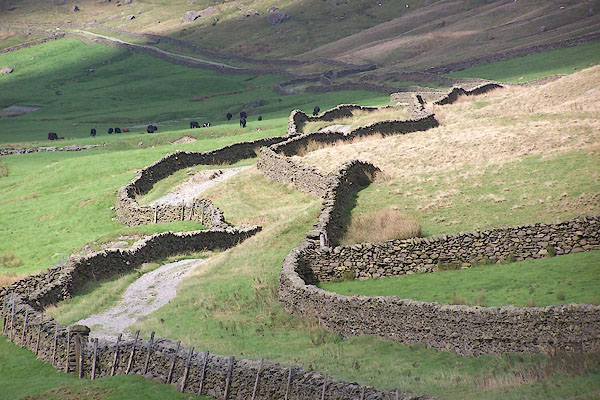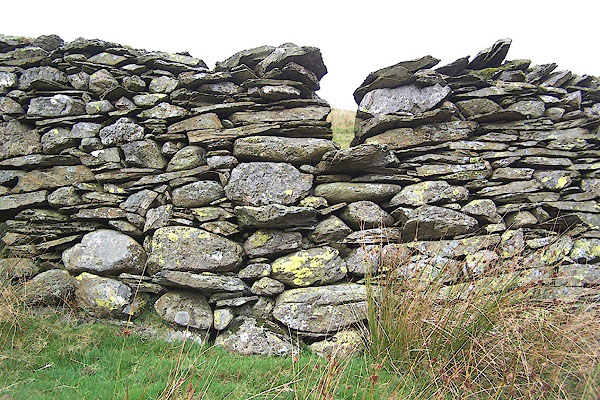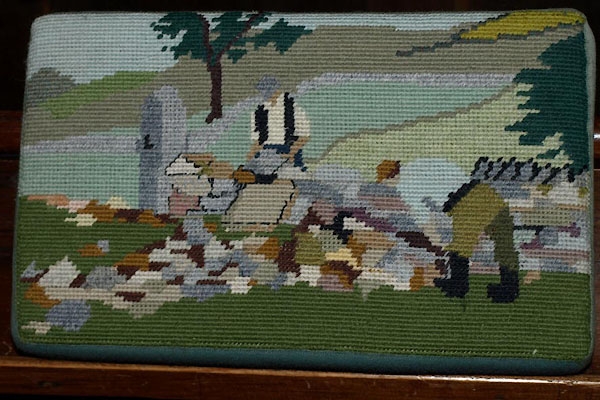




 geology, Cumbria
geology, Cumbria
 sheepfolds, Cumbria
sheepfolds, Cumbria

BMV05.jpg

BMP19.jpg

BVU75.jpg
 goto source
goto sourcepage 45 "... the singular appearance which the sides of many of these mountains exhibit, intersected, as they are, almost to the summit, with stone walls. When first erected, these stone fences must have little disfigured the face of the country; as part of the lines would every where be hidden by the quantity of native wood then remaining; and the lines would also be broken (as they still are) by the rocks which interrupt and vary their course. ..."
 goto source
goto sourcepage 46 "... [a] sylvan appearance is heightened by the number of ash-trees planted in rows along the quick fences, and along the walls, for the purpose of browzing the cattle at the approach of winter. ..."
 goto source
goto sourcePage 59:- "... we know of no obstacle to his doing it [the Fairfield horseshoe], unless it be the stone wall which divides the Scandale from the Rydal side of the ridge. These stone walls are an inconvenience to pedestrians, and a great blemish in the eyes of strangers. In the first place, however, it is to be said that an open way is almost invariably left, up every mountain, if the rover can but find it; and, in the next place, the ugliness of these climbing fences disappears marvellously when the stranger learns how they came there.- In the old times, when there were wolves, and when the abbots of the surrounding Norman monasteries encouraged their tenants to approach nearer and nearer to the Saxon fastnesses, the shepherds were allowed to inclose crofts about their hillside huts, for the sake of browsing their flocks on the sprouts of the ash and holly with which the hillsides were then wooded, and of protecting the sheep from the wolves which haunted the thickets. The inclosures certainly spread up the mountain sides, at this day, to a height where they would not be seen if ancient custom had not drawn the lines which are thus preserved; and it"
 goto source
goto sourcePage 60:- "appears, from historical testimony, that these fences existed before the fertile valleys were portioned out among many holders. Higher and higher ran these stone inclosures,- threading the woods, and joining on upon the rocks. Now, the woods are for the most part gone; and the walls offend and perplex the stranger's eye and mind by their unsightliness and apparent uselessness; but it is a question whether, their origin once known, they would be willingly parted with,- reminding us as they do of the times when the tenants of the abbots or military nobles formed a link between the new race of inhabitants and the Saxon remnant of the old. One of these walls it is which runs along the ridge and bounds Rydal Park. There may be a gate in it; or one which enables the stranger to get round it. If not, he must get over it; and, if he does so, high enough up, it may save him another climb."




Bodman, Janet: 1984: Lake District Stone Walls: Dalesman Books (Clapham, Lancaster):: ISBN 0 85206 777 1; with a geological sketch map
Garner, Lawrence: 1984: Dry Stone Walls: Shire Publications: album 114: ISBN 0 85263 660 0
Gray, Anna: 2005: Dry Stone Walls (leaflet): Cumbria Fells and Dales Leader+ Programme
Rainsford-Hannay, F, Colonel: 1957: : Faber and Faber (London):: includes poems about wallers
Rainsford-Hannay, J: 1972: Dry Stone Walling
Raistrick, Arthur: 1946 &1976 (7th impression): Pennine Walls: Todd, George and Son (Whitehaven, Cumberland):: ISBN 0 85206 012 2
Rollinson, William: 1978: Lakeland Walls: Dalesman (Clapham, Lancaster):: ISBN 0 85206 449 7; has notes about the enclosures, and a geological sketch map
Rollinson, William: 1998: Making Drystone Walls: Smith Settle (Otley, West Yorkshire):: ISBN 1 85825 097 8
